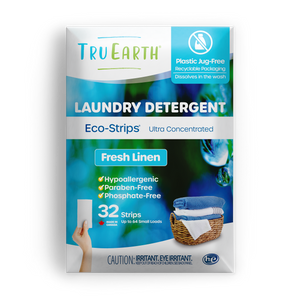Halloween is a fun and festive time of year when many people go all out with decorations. Spooky ghosts, skeletons, cobwebs, and pumpkins adorn front yards, creating a thrilling atmosphere for the holiday.
However, once Halloween is over, taking down these decorations and cleaning up your yard begins. We'll explore various strategies in this guide to make this process more sustainable, environmentally friendly, and efficient.

The Importance of Sustainable Cleanup
Halloween decorations are often made of various materials, including plastics, foam, and fabrics. If not managed properly, these items can end up in landfills, contributing to environmental pollution.
By adopting sustainable cleanup practices, you can reduce waste, conserve resources, and minimize your carbon footprint.
Begin with a Plan
A well-thought-out plan is the first step to an efficient and sustainable yard cleanup. Before removing any decorations, assess your yard and create a checklist of tasks. This approach will streamline the process and help you minimize waste. Here are some essential planning tips:
Inventory Check
Take stock of all your Halloween decorations and identify those in good condition that can be stored for future use.
Recyclable vs. Non-Recyclable
Separate your decorations into two categories: recyclable and non-recyclable. This will make it easier to dispose of items in an environmentally responsible manner.
Donation Pile
If you have decorations that you no longer wish to use, consider donating them to local schools, community centers, or thrift shops. This promotes reuse and benefits others.
Composting
Organic decorations like pumpkins and cornstalks can be composted. This not only reduces waste but also creates nutrient-rich compost for your garden.
Set Clear Goals
Establish specific objectives for your cleanup, such as reducing waste by a certain percentage or ensuring that all materials are properly recycled.
Responsible Decoration Removal
As you embark on the task of taking down your Halloween decorations, be mindful of the materials used in each item. Some materials can be recycled, while others are unsuitable for standard recycling bins. Here's how to approach the responsible removal of different decoration types:
1. Plastic and Foam Decorations
Carefully disassemble large plastic or foam decorations, and check whether your local recycling program accepts these materials.
If they do, clean and place these items in your recycling bin. Ensure they are free from contaminants like tape or other non-recyclable materials.
If your recycling program doesn't accept these items, look for alternative recycling centers or collection points that might.
2. Fabric and Textile Decorations
Fabric decorations, such as costumes, can often be donated or repurposed. Consider donating them to schools or theater groups or repurposing them for other craft projects.
If your fabric decorations are no longer usable, they may still have value as textiles for recycling. Research local textile recycling programs or centers that accept old clothing and materials.
3. Pumpkins and Organic Decor
Pumpkins, gourds, and cornstalks are all organic decorations that can be composted. Ensure they are clean of non-compostable materials, and add them to your compost pile.
Alternatively, check if your local waste management service provides curbside collection of organic materials for composting.
4. Paper Decorations
Paper decorations like banners, signs, and paper-based props can typically be recycled with paper and cardboard. Be sure to remove any non-paper elements like plastic or metal.
5. Electronic Decorations
Battery-operated or plug-in decorations should be handled with care. If they are no longer working or damaged, they may contain electronic components that need particular disposal.
Contact your local e-waste recycling facility or a nearby electronics store to inquire about proper disposal methods for electronic decorations.
Following these guidelines can reduce waste and ensure that Halloween decorations are adequately recycled or repurposed, contributing to a more sustainable yard cleanup.
Sustainable Cleaning Practices
Once your Halloween decorations are safely stored or responsibly disposed of, it's time to tackle the cleaning aspect of your yard. Sustainable yard cleaning doesn't have to be complicated; it often simplifies the process and minimizes your environmental impact. Here are some eco-friendly cleaning practices to consider:
1. Reusable Cleaning Tools
Opt for reusable cleaning tools such as brooms, rakes, and cloth towels. These are more sustainable than disposable alternatives.
2. Chemical-Free Cleaning
Use chemical-free cleaning solutions or make your own by mixing water with vinegar or baking soda. This reduces the use of harmful chemicals that can harm the environment.
3. Composting Yard Waste
Collect leaves, branches, and other organic yard waste in a compost bin rather than sending it to a landfill. This will create nutrient-rich compost for your garden.
4. Eco-Conscious Disposal
If you need to dispose of any non-compostable yard waste, check local disposal sites or recycling centers that promote eco-friendly practices.
5. Energy-Efficient Tools
If you need powered equipment for yard cleanup, ensure it's well-maintained and energy-efficient. Proper maintenance reduces emissions and energy consumption.

Wrapping Up a Sustainable Cleanup
Halloween is a time for fun and creativity, and responsible yard cleanup allows you to extend these values to the post-celebration phase. A sustainable approach reduces your environmental footprint and sets a positive example for your community.
In summary, a sustainable yard cleanup after Halloween starts with planning, responsible decoration removal, and eco-friendly cleaning practices. By consciously managing your waste, recycling materials, and minimizing your environmental impact, you can enjoy a clean yard while caring for the planet. So, the next time you take down your Halloween decorations, remember that sustainability is the best treat for the environment.


